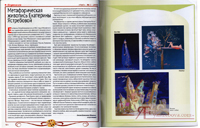Metaphoric painting of Ekaterina Yastrebova
The enlightened and life-asserting works of Ekaterina Yastrebova are distinguished with the strict, scrupulous style of performance.

The densely populated, worked in details pictures of the painter are close to the masterpieces of North Renaissance through their accuracy and true. Her pictures could be looked at endlessly all the time with admiring with new nuances and details. The rare skill nowadays distinguish the creative work of the painter. The topics chosen by Ekaterina Yastrebova are often phantasmagoric and paradoxical.
That are the passerby rushing forward the green light of the traffic light and sweeping everything off their way or people snowed under the pile of newspapers and making with them different manipulations.
The lover world on the pictures of the painter are grown out by certain dwarfish creatures, cover with the paintings of rivers, bridges, towns, parks. The changes of the seasons happen therein, camelcades are wandering, boats are lying alongside. This world is isolated and exclusive. It concentrates on itself, it is closed for the external influence, its inner beauty grows through into the outer world, blossoms out with gardens or envelops the lovers with the cover of the snowed up boulevards of the town falling asleep.
In a little bit ironical view of the painter the happiness is a delicate balance between the man and the woman where on the one hand the naked hopelessness and despair reign, on the other hand
the paper efficiency. The theme of paper, newspapers, their prevalence in the modern life are reflected more in the picture “Evening”. Our life is the constant information intake that was perfect reproduced through the overwhelming number of newspapers hanging on the stands, covering job ladder steps of the clerk. The newspaper cliche pinned to his umbrella point serve as a protection and the upwards promotion device for him. The human disconnection reads in the individual information intake: people don't see and don't hear each other, they have forgotten how to communicate. Only one boy for joy makes paper planes from newspapers.
The motif of the stage occurs on the pictures of the painter. Sometimes it helps to dismiss the fussy crowd, sometimes it emphasizes the senseless of the career raising.
The pictures don't have a n outright emotional colour, they just state such and such with making the audience to think.
The metaphorics of the artistic language of Ekaterina Yastrebova, the singer of the urban landscape, especially compels attention to the picture of the same name in which the reality and paradoxicality are near again, in which the picture painted by the painter is merging with the landscape outside the window, where it is no edge of the art and reality. The painter always lives in his own world made with his imagination and nourished with his endless fantasy. The house of the painter is a delicate construction hanging in air. The painter “with Saskia on his knees” creates in the ephemeral space which can crash down or carry away in a flash.
These constructions are not utilitarian but they are the debris and fragments of the architectural masterpieces of the past brought together. Here the pyramid is close to the strong ionic column miraculously, the Romanic castle to the Venetian loggia, surreal buildings to the Gothic sculpture. Everything is so flexible and dynamic in this unreal composition of the “frozen music” that wakes up the feeling of the polyphonic improvisation. The architectural phantasmagoria also dominates in the picture “Take me with you, please”. The travellers on the bicycles are carrying behind them the whole buildings of their remembers, feelings and thoughts, their natives, friends and acquaintances. To the painter's mind the person can't be taken out of the context of his life. He is burdened with his past and present as a snail with its shell.
The series devoted to the Parnassus' residents is very original. Ekaterina Yastrebova doesn't false to her credo of the ironical painter of scenes of everyday life and she shows the daily life of the deities: the gods plait hairs, manicure nails, lace up their sandals. Putti are preparing to flight with the help of caring mothers, learning how to draw wings and shooting from small bows into shooting marks.
There is deep thinking and multi-aspect associative lines behind the playful form of the material feed. The assemblage of eccentric men are rushing by various rolling carriages in a closed circle to the call of the green eyes of traffic lights on the picture of “Green light”. Carriages, carts, cages, rollers, car tyres,even hose rolls are the means of travel of the possessed crowd. It was painted in 1994 and it is very close to Pelevin's “Yellow arrow” written at the same time because of the doom of the motion in a circle, the impossibility and unwillingness to break this closed marathon.
The pictures of the new thousand years are less dramatical. They glorify the love, the friendship between women, the relationships between the painter and the model.
Oksana Ermolaeva-Vdovenka